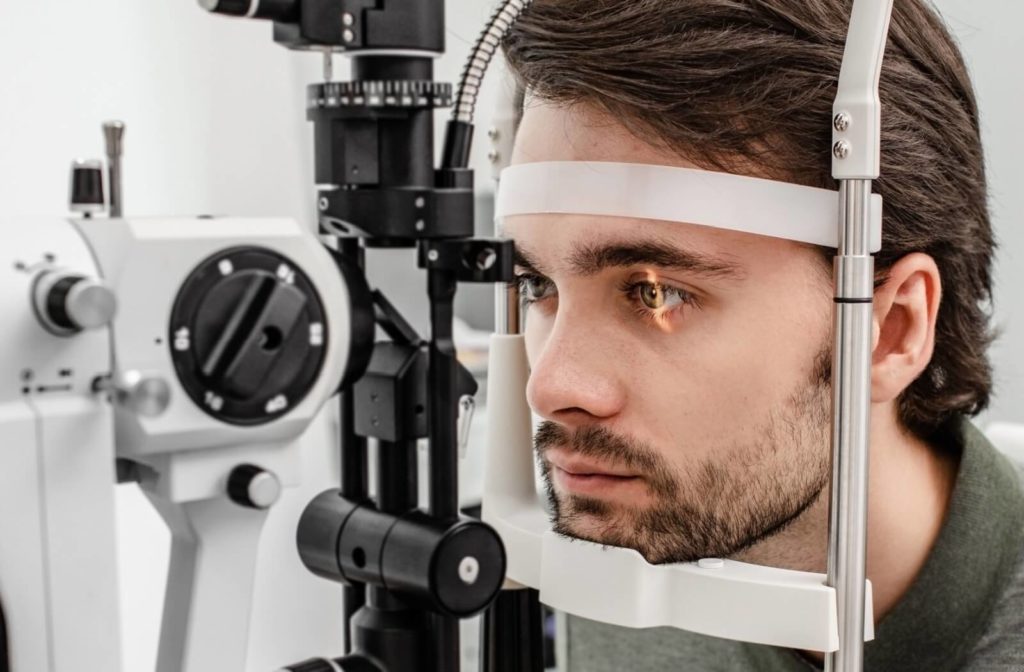The vibrant spectrum of colors that surrounds us enriches our experience of the world, from the blue hues of the sky to the lush greenery of nature. However, for a portion of the population, this symphony of colors lacks some of its richness and depth.
Color blindness, or color vision deficiency, affects a significant portion of the population, with men being more commonly affected than women. Thankfully, color blindness can be detected during a comprehensive eye exam. If you’re curious about what else a comprehensive eye exam can detect, contact us to help answer any questions.
You might be wondering: why are men more prone to color blindness than women? The answer lies in the genetic inheritance of color vision.
How Is Color Blindness Inherited?
The genes responsible for color vision are located on the X chromosome. Since men have only one X chromosome (XY), any genetic mutation on that chromosome that affects color vision will manifest more easily.
In contrast, women have two X chromosomes (XX), providing a potential safeguard against color blindness. If one X chromosome carries a mutated gene for color vision, the other X chromosome may carry a normal gene, allowing women to retain some level of color vision.
This genetic predisposition means that men are more likely to inherit color blindness from their mothers, who may be carriers of the mutated gene on one of their X chromosomes.
Furthermore, certain types of color blindness, such as red-green color blindness, are more prevalent in men due to the specific inheritance patterns of these genetic mutations.
Types of Color Blindness
Not all color vision deficiencies paint the same picture. There are several types, each affecting the way colors are seen in unique ways.
- Deuteranomaly
- Protanomaly
- Tritanomaly
- Complete Color Blindness (Monochromacy)
Deuteranomaly
Deuteranomaly is the most prevalent form of color vision deficiency. It dulls the brightness of greens and reds, making these colors tougher to distinguish. People with deuteranomaly may struggle to perceive subtle differences between shades of green and red.
Protanomaly
Protanomaly also affects red-green recognition but does so by dimming reds more than greens.
Tritanomaly
Tritanomaly is a rarer form of color vision deficiency. In this type, blues and yellows can get mixed up. While tritanomaly is less common compared to deuteranomaly and protanomaly, it still poses challenges in accurately identifying and distinguishing between blue and yellow hues.
Complete Color Blindness (Monochromacy)
For people with complete color blindness or monochromacy, the world is seen in shades of gray. This extremely rare condition strips away the spectrum entirely, leaving them unable to perceive any colors other than varying shades of gray.
Each type of color vision deficiency provides a different lens to view the world, showcasing the diverse range of color perception and highlighting the complexities of the human visual system.
How Can Your Eye Doctor Help with Color Blindness?
Optometrists play a crucial role in supporting people with color blindness by providing education, guidance, and specialized tools to help manage and cope with color blindness.
Vision Assessment
Optometrists conduct comprehensive eye exams, including color vision tests, to diagnose and evaluate the severity and type of color blindness.
Through these assessments, optometrists can accurately determine the extent to which color vision is affected and tailor their recommendations for you.
Specialized Lenses and Filters
They may recommend specialized lenses or filters designed to enhance color perception for people with certain types of color blindness.
These lenses can help improve color vision and make it easier for people to distinguish between different hues in their environment.
Assistive Devices
Your eye doctor can provide information and guidance on the use of assistive devices, such as:
- Color identification apps
- Color-coded aids
- Digital tools
To assist people with color blindness in various tasks and activities. These devices can help compensate for color vision deficiencies and enhance independence and quality of life.
Counseling and Support
Your eye doctor can also offer counseling and emotional support to people with color blindness, addressing any concerns, frustrations, or challenges they may face.
By providing a supportive and empathetic environment, they can help with the psychological and social aspects of living with color vision deficiency.

Regular Monitoring and Follow-up
Your optometrist will go over the importance of regular eye exams and follow-up appointments to monitor changes in vision and assess the effectiveness of any interventions or tools recommended for managing your color blindness.
This ongoing monitoring ensures that you receive appropriate care and support to optimize your visual function and well-being.
By offering comprehensive care, tailored tools, and compassionate support, optometrists like the ones at Total Vision Sports Arena play a vital role in helping people with color blindness navigate their visual challenges.
If you think you or a loved one may have color blindness, don’t hesitate to book an eye exam with our team.



